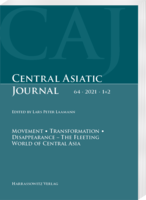|
|
more titles of the subject:
Download:
Please note: With adding digital Products to your cart
the payment will be handled via PayPal. The download will be provided after the payment is confirmed. The Central Asiatic Journal is devoted to the linguistic, cultural, and historical heritage of Central Asia. Most contributions relate to the geographical remit of the Central Asian core region, i.e. Mongolia, Turkestan/Xinjiang, Tibet, Siberia, and Manchuria. By extension, however, this definition can include a secondary sphere extending into all of western Asia, the Himalayas, China’s Han-majority provinces and the Pacific fringe region (Korea, Japan, and eastern Siberia). Articles are published in English, German, French, Russian, and Chinese. The Central Asiatic Journal is fully peer-reviewed.
The journal has started publishing contributions in thematic clusters, and focuses on Mongolia, its surrounding regions and the historical implications of Mongolian expansion , on the Tangut people and the Xi-Xia (His-Hsia) state , and on the contribution of the Manchus to China’s more recent history. Further issues are focused on the migration and nation-building in central and western Asia and discussing historical Central Asia. From the contents (altogether 17 contributions): Pavel Rykin, Mongolic Historical and Comparative Linguistics: State-of-the-Art and Recent Advances Gao Jingyi, Huns and Xiongnu Identified by Hungarian and Yeniseian Shared Etymologies II Wang Yingzi, Jerim League during the Late Qing Reforms (1907–1911) as a Case Study of Late Imperial China’s Frontier Policy and Inter-Ethnic Administration Alexander Alexeevich Kim, The Horse in Bohai and Jurchen Societies – Based on Osteological Studies from the Southern Part of the Russian Far East Shioya Akifumi, The Association between the Descendants of Sufi Saint Sayyid Ata and the Khans of Khiva at the Beginning of the 19th Century Christopher P. Atwood, Ila, Qada, and Qu the Hunchback: Three Jin Generals in Mongol Historiography |
|||||||||||||||||||||||||||||||||||||||






